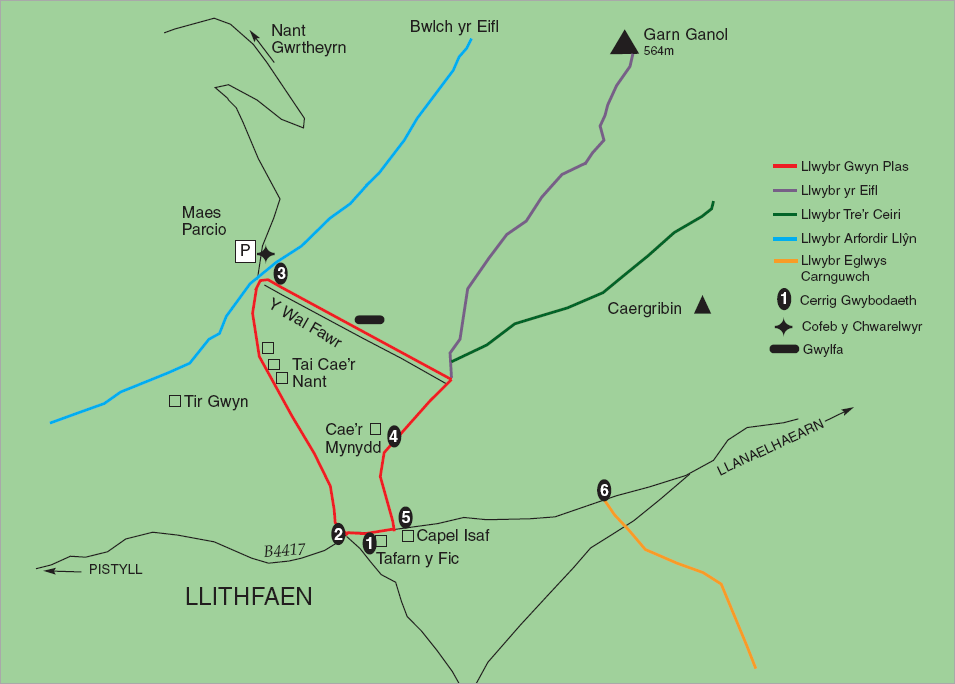
Robert William Hughes, Cae'r Mynydd
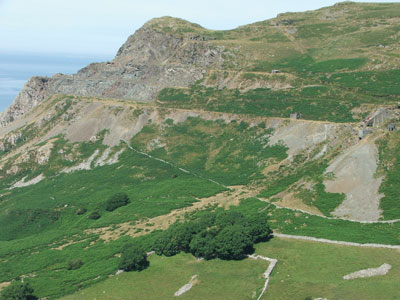 In 1812, estate officers, lawyers and surveyors came to Llithfaen
to survey the common land. There were numerous one-night houses
(tai unnos) and many squatters inhabited the mountain as they
had always done. One such house was Cae'r Mynydd. With the
enclosure of common land, only those who had lived on these
lands for twenty years or more were allowed to retain their
property.
In 1812, estate officers, lawyers and surveyors came to Llithfaen
to survey the common land. There were numerous one-night houses
(tai unnos) and many squatters inhabited the mountain as they
had always done. One such house was Cae'r Mynydd. With the
enclosure of common land, only those who had lived on these
lands for twenty years or more were allowed to retain their
property.
Robert William Hughes of Cae'r Mynydd used a large sea-shell to convene the residents of Llithfaen calling upon them to resist the officers and surveyors in September 1812. The residents congregated on the mountain and showered the officers with stones. A few days later, the Dragoons arrived at Llithfaen and some of the rioters were caught and imprisoned for six months. But on that occasion too, the sea-shell was put to good use, and most of the rioters succeeded in fleeing to the mountain to hide from the horsemen.
The authorities came to consider Robert Hughes, the shell man, as 'Captain of the mob'. The Dragoons returned to Llithfaen in March 1813, but yet again, found all the houses deserted. The soldiers returned at night, and according to folklore, they caught Robert Hughes at Cae'r Mynydd, hiding in a bread rack which hung from a ceiling rafter. Numerous skirmishes occurred as the horsemen caught other rioters and took them to Caernarfon gaol. They avoided the path over the Eifl and through Llanaelhaearn - and opted for the far safer lowlands skirting Pwllheli and Tremadog.
' The king against Robert William Hughes, for a Riot' was the charge put in court. Some of the rioters were fined and imprisoned - a number of women amongst them - but Robert Hughes and another called David Rowlands were sentenced to death by hanging. Eventually they were 'pardoned' - Robert Hughes was transported to Australia in 1813 to spend the remainder of his life in Botany Bay.
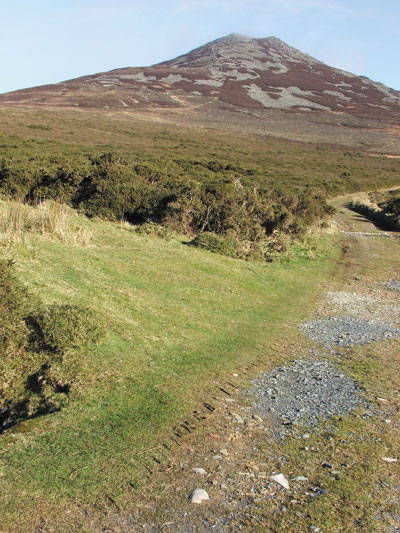 Y Wal Fawr
Y Wal Fawr
(lit. 'The Tall Wall'; the boundary between enclosed fields and the mountain common land)
This mountain wall was built circa 1815 by unemployed soldiers who had returned from the battle of Waterloo. The grid-like fields, marked out by surveyors, date from the same period - this was the land that was stolen from the people by the Eifl Common Lands Enclosure Act.
The working man is gaoled and fined
For stealing geese from common land;
But he who steals the land from geese
Is well respected, fine and grand.
At the end of the 18th century in particular, efforts to gain possession of the highlands and enclose them began in earnest. This entailed the enclosure of approximately a quarter of Wales's land - common lands which until that time ordinary folk had been free to use as pasture and a source of peat. This concerted campaign lasted well into the last half of the 19th century, transforming not only the living conditions of ordinary people but also the economy and landscape of rural areas in general. It is estimated that in excess of a million acres of Welsh land were enclosed during this period, about one fifth of the whole country.
Tafarn y Fic
The public house was built in 1869 and originally consisted of four small rooms. Doctor Jac, the local general practitioner, held his surgery in one of the back rooms. Another back room was set aside for the 'Paddies' who came up from Nant Gwrtheyrn.
In 1988, a number of people formed a co-operative and raised money to purchase the public house, which by that time had been closed by the brewery. It became an important community venue in Llyn and its evenings of Welsh language entertainment became renowned throughout the area. Additional funding was attracted to the venture and the building was modernized and extended in 2004. The Fic re-opened its doors, and a new era began with performances by some of Wales's most prominent artists and also evenings of local homespun entertainment called Lol Botas.
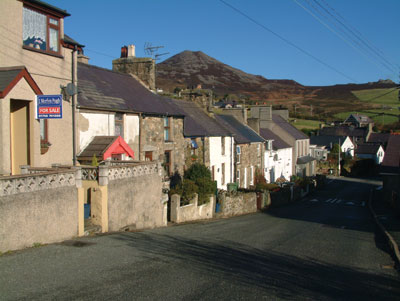 Carnguwch Church
Carnguwch Church
The history of the church dates back to the seventh century and it is consecrated to Saint Beuno, the patron saint of Clynnog, Penmorfa, Aberffraw, Trefdraeth, Llanycil, Gwyddelwern, Beriw and Betws (Maldwyn) and Llanfenno in Herefordshire. His feast day is the 21st of April.
The parish name (and the mountain's) is a bit of a mystery. Some venture that Cuwch was a Saint (there is a Llangiwch yn Swansea) and it was not unusual to have two saints within the same parish.
Carnguwch chapel came under the auspices of the mother church at Clynnog, and it served as a church to this parish. Some of the features of the present building are its robust stonework, the square bell tower and the ancient form of Lectern and Pulpit - one beneath the other. It has a square seating area for the Llwyd family of Trallwyn.
The church stands in a peaceful rural location above a steep slope which runs down to the banks of the river Erch. The Curate at Pistyll held a Sunday afternoon service here until 1882 and by that time, St James's Church at Llithfaen had been built to serve the new population that had grown in the village.
The church was deconsecrated, but people were still buried in the churchyard until the 1970s. At the end of the twentieth century, an association called the Friends of Carnguwch Church was formed in order to conserve the building. The churchyard wall was rebuilt, voluntary work carried out to the roof, the tower, and the windows and the interior was repainted. The Friends held a service at the church in June 2008 which was attended by more than one hundred people.
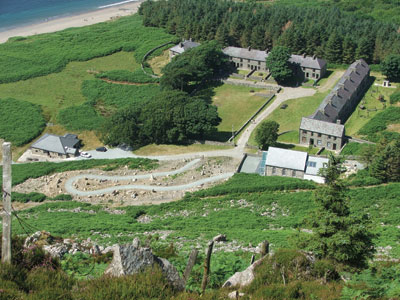 The Eifl Quarries
(on the Llithfaen side)
The Eifl Quarries
(on the Llithfaen side)
There were three granite quarries on the western side of the Eifl and the quarrymen of Llithfaen and Nant Gwrtheyrn worked at these sites. Chwarel y Nant, Chwarel Cae'r Nant, Chwarel Carreg y Llam.
Chwarel Carreg y Llam was opened in 1908 and it was the last to close - in November 1963. The same company owned Chwarel y Nant near Nant Gwrtheyrn - in the early years, that quarry had its own boats, each one's name comprising the element 'maen' meaning 'stone': Calchfaen, Gwynfaen, Torfaen, Llysfaen and Sylfaen. Sylfaen once carried explosives to the war in the Transvaal.
Chwarel y Nant specialized in making sets which were exported to pave the streets and pavements of English cities. The stones would be tipped down the chutes from the wagons. The quarrymen called these wagons 'Pharo's Chariots' because they were so heavy to push.
Each quarry gallery had its own name and here are some of the names used for the galleries at Chwarel y Nant: Ponc Uchaf (Top Gallery), Bach (Small), Isaf (Lowest), Sir Fôn (Anglesey), Buenos Aires, Palestina and Clogwyn Nefyn (Nefyn Cliff). The village of Nant Gwrtheyrn was built in the wake of the industry at the Nant in the 1860s. The two terraces were called Sea View and Mountain View with Bay View on the corner, opposite Seilo Chapel (built in 1878). Next to Bay View, was the Co-op Shop and behind it, the bakehouse. The Plas (mansion house) was the luxurious home of the quarry manager.
At the end of the second World War, two trucks - eight wheel vehicles which could travel by land and by sea - ran between Chwarel y Nant and Carreg y Llam to transport materials from the Nant when the quarry was closed.
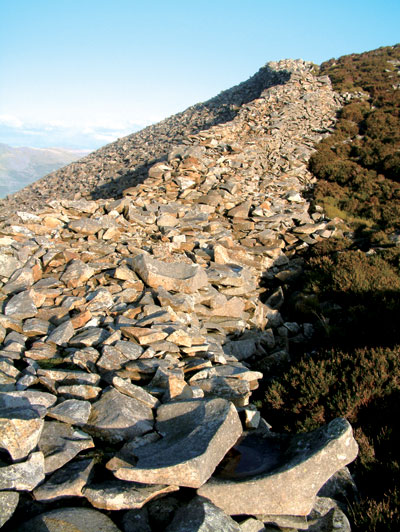 Llithfaen Chapel and
Choir
Llithfaen Chapel and
Choir
As Llithfaen stands on the old main road from Arfon to Llŷn, it was to this village that the first Methodist preachers came. According to tradition, the first preaching service was held at Cae Grug, beside the spot where Moriah Chapel was later built. It was a summer's day and a cart was used as a pulpit.
The first place of worship was a small farmhouse called Abergafren and the first chapel was built in around 1780 where the Ganolfan (the community centre at the old school) now stands. The chapel had a thatched roof and an earth floor.
The second chapel was built on the farmland of Llithfaen Fawr, (1804) - on the opposite side of the hedge to where the present chapel stands. There too, the third chapel was built in 1834, and the Day School also used that building. In 1841, the population of Pistyll parish stood at 514 and the population of Carnguwch at 119.
The fourth chapel was built in 1870, on the site of the present building - it was one of the largest examples of a chapel without a gallery in Llyn and Eifionydd. In twenty years time, that chapel also proved too small and the foyer and the chapel itself had to be knocked through to create more seating space.
By the beginning of the twentieth century, the chapel either had to be repaired or rebuilt. A decision was made to build a new chapel and add a vestry. Evan Roberts 'the Revivalist' held the first religious service in the new chapel on 12th December, 1905. By 1901, the population of the two parishes was as follows: Pistyll-739, Carnguwch-112.
The chapel's most striking feature is its curved gallery for the choir behind the Deacon's Seat and the pulpit - it is unique in Wales and the reason why the building is listed for conservation purposes. The choir gallery is a reflection of the notable choral tradition in the Llithfaen area - it once boasted exceptional male voice, mixed and children's choirs. This culture reached its peak when Llithfaen Male Voice Choir won first prize at the Pwllheli National Eisteddfod in 1925 and again at Mountain Ash in 1945.
Bibliography
- Gwyn Plas' files
- O Ben Llŷn i Botany Bay, Ioan Mai, Gwasg Carreg Gwalch, 1993
- Llŷn, Elfed Gruffydd, Gwasg Carreg Gwalch, 1998
- Building Fund Report for M.C. Chapel Llithfaen, Pwllheli 1910
